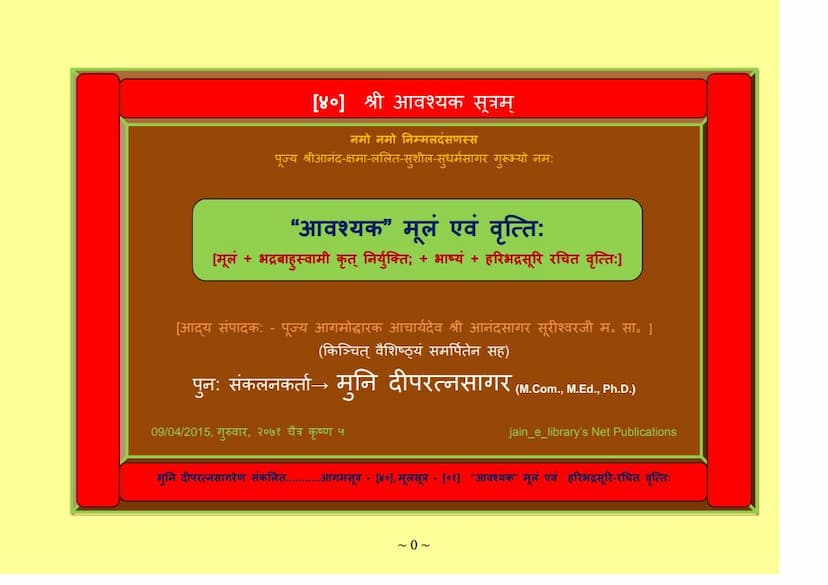Aagam 40 AAVASHYAK Moolam Evam Vrutti
Added to library: September 1, 2025

Summary
This is a comprehensive summary of the Jain text "Aagam 40 AAVASHYAK Moolam evam Vrutti" by Dipratnasagar, Deepratnasagar, based on the provided text snippets:
Overall Context:
The text is identified as Aagam 40, "Aavashyak" Moolam evam Vrutti, a compilation and commentary on the Aavashyak Sutra, a fundamental Jain scripture. The publication is attributed to Deepratnasagar, with Munishri Deepratnasagar as the compiler. It's noted as a net publication from the 'jain_e_library'. The text is presented in a scholarly format, including the original Sanskrit/Prakrit text, commentary (vritti), and often references to the Niryukti and Bhashya, classical commentaries on Jain scriptures. The edition appears to be a revival and collation of an older 1916 publication edited by Acharya Dev Shri Anand Sagar Surishwarji.
Key Components of the Text:
The "Aavashyak Sutra" (also referred to as "Aavashyak Mulam") is the core text. This is complemented by:
- Niryukti: A critical analysis and interpretation, often attributed to Bhadrabahu Swami. This provides a foundational commentary.
- Bhashyam: A further elaboration and explanation, sometimes attributed to Acharya Haribhadra Suri.
- Vritti: A detailed commentary, specifically attributed to the renowned Acharya Haribhadra Suri in this context. This is a significant part of the compilation.
Structure and Content Outline (Based on Table of Contents and Page Snippets):
The text is structured around the six essential duties (Aavashyaka) of a Jain monk, and likely also discusses principles relevant to lay followers (shravaks). The content is divided into several "Adhyayanas" (chapters or sections), each focusing on a specific aspect of the Aavashyak Sutra. Based on the page content, the following studies (Adhyayanas) are covered:
- Samayikam (सामायिक): This study likely details the practice of equanimity, meditation, and the spiritual discipline undertaken for a fixed period. It covers the nature, principles, and importance of Samayikam.
- Chaturvinshati Stava (चतुर्विंशतिस्तव): This section probably deals with the praise or adoration of the 24 Tirthankaras, highlighting their virtues and teachings.
- Vandanam (वंदन): This study would focus on reverence, respect, and submission, likely discussing the proper ways to honor the enlightened beings (Arihants, Siddhas, Gurus, Sadhus) and the underlying principles of this practice.
- Pratikramanam (प्रतिक्रमण): This would cover the process of introspection, confession, and atonement for transgressions, detailing various types of Pratikramanas (e.g., related to sleep, alms-seeking, study, etc.).
- Kayotsargam (कायोत्सर्ग): This study likely explains the practice of bodily abandonment, detachment, and spiritual contemplation, possibly including the recitation of devotional verses like Shruta Stava and Siddha Stava.
- Pratyakhyanam (प्रत्याख्यान): This section would detail the vows, renunciations, and commitments made by Jain ascetics and lay followers, possibly including the vows related to right faith and conduct.
Commentary Style (Haribhadra Suri's Vritti):
Acharya Haribhadra Suri's commentary (Vritti) is a central feature. The text highlights his approach:
- Scholarly and Detailed: The commentary provides extensive explanations, delving into etymology, philosophical concepts (like Naya, Nikshepa, Pramana), historical narratives (Kathanaka), and the reasoning behind Jain practices.
- Inclusion of Niryukti and Bhashyam: Haribhadra Suri's Vritti builds upon the earlier Niryukti and Bhashya, presenting a comprehensive understanding of the Sutra.
- Linguistic Analysis: The commentary includes explanations of Prakrit and Sanskrit terms, grammatical structures, and the nuanced meanings of words.
- Elaboration on Key Concepts: The text meticulously explains concepts such as the types of knowledge (Mati, Sruta, Avadhi, Manahparyaya, Kevala), the nature of karma, the principles of merit and demerit (Mangala), and various aspects of spiritual discipline.
- Use of Analogies and Examples: To clarify complex ideas, the text often employs analogies and illustrative stories.
The Publisher's Note (Munishri Deepratnasagar):
The publisher's note by Munishri Deepratnasagar is particularly significant. It reveals:
- Re-publication of an Ancient Work: This publication is a careful reproduction of a 1916 edition edited by Acharya Anand Sagar Surishwarji.
- Critique of Pirated Editions: Munishri Deepratnasagar expresses strong disapproval of other publishers who have simply offset the 1916 edition, claiming it as their own work without proper attribution or adding original value. He considers this a form of "adatta-daan" (unauthorized giving/taking) and an "inappropriate attempt to prove themselves as great custodians of Agamas."
- Preservation of Ancient Tradition: He emphasizes the value of respecting the ancient format and the faith in the original work.
- Modern Digital Format: The current publication is presented in a digital format via jain_e_library.org for wider and easier access.
- Methodology: The compiler has scanned the original text and created a special format that preserves the original content while adding valuable navigational elements like the "Deep Anukram" (sequence number) to help readers easily identify the study, sutra, niryukti, and bhashya on each page.
In essence, this publication is a scholarly endeavor to present a foundational Jain scripture, the Aavashyak Sutra, along with its classical commentaries, in a meticulously organized and accessible format, while also championing the integrity and respect for ancient Jain literature.
The detailed table of contents and the extensive page snippets indicate a deep dive into the intricacies of Jain philosophy, ethics, and practice as expounded in the Aavashyak Sutra and its commentaries, particularly Haribhadra Suri's Vritti.